Build ML web app - assignment 1
Contents
42.53. Build ML web app - assignment 1#
from tensorflow import keras
(x_train, y_train), (x_test, y_test) = keras.datasets.mnist.load_data()
print(x_train.shape)
print(x_test.shape)
(60000, 28, 28)
(10000, 28, 28)
def visualize_input(img, ax):
ax.imshow(img, cmap='gray')
width, height = img.shape
thresh = img.max()/2.5
for x in range(width):
for y in range(height):
ax.annotate(str(round(img[x][y],2)), xy=(y,x),
horizontalalignment='center',
verticalalignment='center',
color='white' if img[x][y]<thresh else 'black')
import matplotlib.pyplot as plt
fig = plt.figure(figsize = (10,10))
ax = fig.add_subplot(111)
visualize_input(x_train[0], ax)
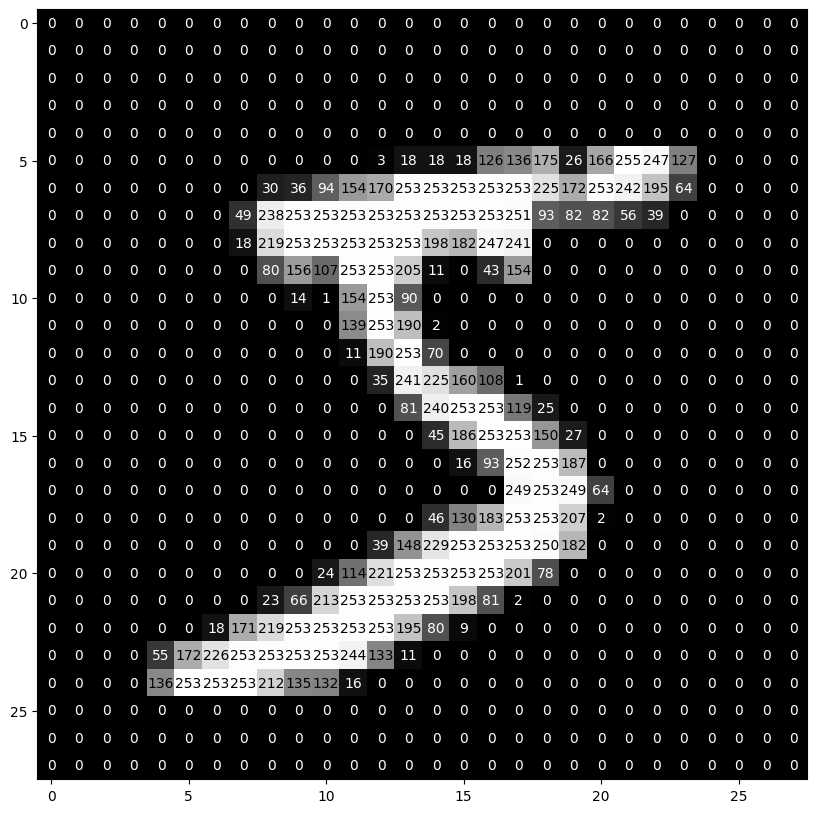
import random
import matplotlib.pyplot as plt
i = random.randint(0,60000)
plt.imshow(x_train[i],cmap='gray') # Color map
plt.title([y_train[i]])
Text(0.5, 1.0, '[2]')
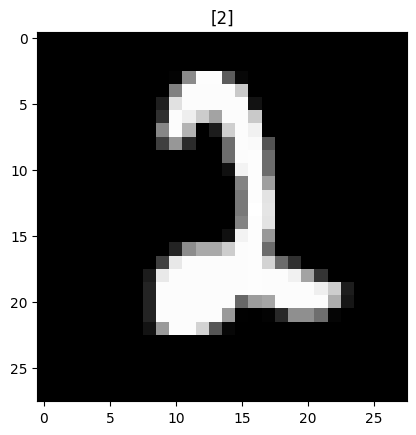
# How many images are there in every digit?
import numpy as np
np.unique(y_train,return_counts=True)
(array([0, 1, 2, 3, 4, 5, 6, 7, 8, 9], dtype=uint8),
array([5923, 6742, 5958, 6131, 5842, 5421, 5918, 6265, 5851, 5949],
dtype=int64))
np.unique(y_test,return_counts=True)
(array([0, 1, 2, 3, 4, 5, 6, 7, 8, 9], dtype=uint8),
array([ 980, 1135, 1032, 1010, 982, 892, 958, 1028, 974, 1009],
dtype=int64))
# Normalization : Scaling down the value to a specific range(0-1)
x_train=x_train/255
x_test = x_test/255
# AFter Normalization
print(x_train.max())
print(x_train.min())
1.0
0.0
from keras.layers import Dense
from keras.layers import Flatten
model = keras.models.Sequential()
model.add(Flatten(input_shape=(28,28))) # 784
model.add(Dense(392,activation='relu'))
model.add(Dense(10,activation='softmax'))
model.compile(optimizer='adam',loss='sparse_categorical_crossentropy',metrics=['accuracy'])
history = model.fit(x_train,y_train,epochs=10,validation_split=0.2)
Epoch 1/10
1500/1500 [==============================] - 13s 8ms/step - loss: 3.2063 - accuracy: 0.8986 - val_loss: 0.6879 - val_accuracy: 0.9189
Epoch 2/10
1500/1500 [==============================] - 12s 8ms/step - loss: 0.3889 - accuracy: 0.9335 - val_loss: 0.4031 - val_accuracy: 0.9345
Epoch 3/10
1500/1500 [==============================] - 12s 8ms/step - loss: 0.3103 - accuracy: 0.9388 - val_loss: 0.3946 - val_accuracy: 0.9368
Epoch 4/10
1500/1500 [==============================] - 12s 8ms/step - loss: 0.2950 - accuracy: 0.9385 - val_loss: 0.3703 - val_accuracy: 0.9377
Epoch 5/10
1500/1500 [==============================] - 12s 8ms/step - loss: 0.2744 - accuracy: 0.9439 - val_loss: 0.3204 - val_accuracy: 0.9419
Epoch 6/10
1500/1500 [==============================] - 12s 8ms/step - loss: 0.2417 - accuracy: 0.9481 - val_loss: 0.2982 - val_accuracy: 0.9454
Epoch 7/10
1500/1500 [==============================] - 13s 8ms/step - loss: 0.2174 - accuracy: 0.9538 - val_loss: 0.3228 - val_accuracy: 0.9504
Epoch 8/10
1500/1500 [==============================] - 11s 8ms/step - loss: 0.2152 - accuracy: 0.9564 - val_loss: 0.3443 - val_accuracy: 0.9463
Epoch 9/10
1500/1500 [==============================] - 12s 8ms/step - loss: 0.2122 - accuracy: 0.9578 - val_loss: 0.4409 - val_accuracy: 0.9382
Epoch 10/10
1500/1500 [==============================] - 14s 9ms/step - loss: 0.2056 - accuracy: 0.9590 - val_loss: 0.3617 - val_accuracy: 0.9479
import matplotlib.pyplot as plt
plt.plot(history.history['loss'])
plt.plot(history.history['val_loss'])
[<matplotlib.lines.Line2D at 0x1799f6b3e80>]
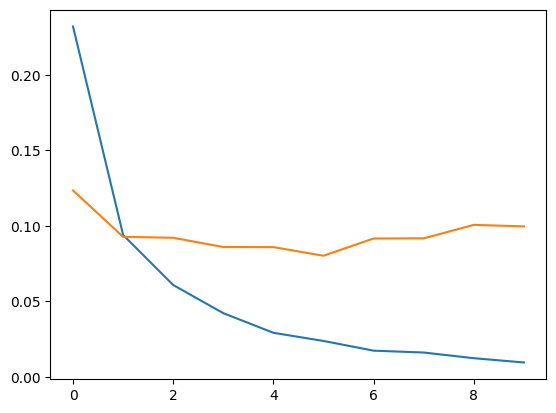
plt.plot(history.history['accuracy'])
plt.plot(history.history['val_accuracy'])
[<matplotlib.lines.Line2D at 0x1799f7b00d0>]
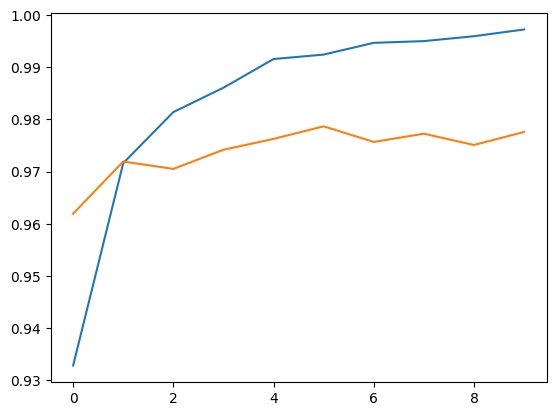
import os
import matplotlib.pyplot as plt
index_of_8 = np.where( y_train == 8)[0][0]
image_of_8 = x_train[index_of_8]
# plt.imshow(image_of_8, cmap='gray')
# plt.show()
if not os.path.exists('./tmp'):
os.makedirs('./tmp')
plt.imsave('./tmp/8.png', image_of_8, cmap='gray')
import keras.utils as image
img = image.load_img(path="./tmp/8.png", color_mode= 'grayscale', target_size=(28, 28))
img = image.img_to_array(img)
plt.imshow(image.array_to_img(img), cmap="gray")
img = img.astype('float')/255
test_img = img.reshape((1, 28, 28, 1))
#img_class = model.predict_classes(test_img)
img_class = np.argmax(model.predict(test_img), axis = 1)
prediction = img_class[0]
1/1 [==============================] - 0s 41ms/step
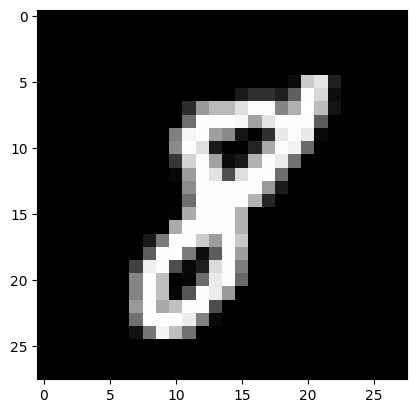
prediction
8
from sklearn.metrics import accuracy_score,confusion_matrix,classification_report
y_pred = model.predict(x_test)
y_pred = np.argmax(y_pred,axis=1)
accuracy_score(y_pred,y_test)
313/313 [==============================] - 2s 6ms/step
0.9807
confusion_matrix(y_pred,y_test)
array([[ 969, 0, 1, 2, 0, 2, 2, 0, 0, 2],
[ 1, 1127, 0, 0, 1, 1, 3, 4, 2, 4],
[ 0, 2, 1007, 2, 2, 0, 0, 6, 3, 0],
[ 0, 0, 1, 991, 0, 11, 1, 1, 2, 3],
[ 1, 0, 4, 0, 970, 1, 1, 0, 4, 15],
[ 2, 0, 0, 3, 0, 868, 2, 1, 4, 5],
[ 2, 2, 2, 0, 3, 3, 949, 0, 1, 1],
[ 1, 1, 7, 5, 2, 0, 0, 1012, 2, 14],
[ 2, 3, 9, 5, 0, 4, 0, 1, 952, 3],
[ 2, 0, 1, 2, 4, 2, 0, 3, 4, 962]],
dtype=int64)
print(classification_report(y_pred,y_test))
precision recall f1-score support
0 0.99 0.99 0.99 978
1 0.99 0.99 0.99 1143
2 0.98 0.99 0.98 1022
3 0.98 0.98 0.98 1010
4 0.99 0.97 0.98 996
5 0.97 0.98 0.98 885
6 0.99 0.99 0.99 963
7 0.98 0.97 0.98 1044
8 0.98 0.97 0.97 979
9 0.95 0.98 0.97 980
accuracy 0.98 10000
macro avg 0.98 0.98 0.98 10000
weighted avg 0.98 0.98 0.98 10000
model.save("mnist.hdf5")
42.53.1. Now it’s time to use our hdf5 model file for prediction!#
import streamlit as st from streamlit_drawable_canvas import st_canvas from tensorflow import keras import cv2 import numpy as np model_new = keras.models.load_model(‘mnist.hdf5’)
st.title(“MNIST Digit Recognizer”)
SIZE = 192
canvas_result = st_canvas( fill_color=“#ffffff”, stroke_width=10, stroke_color=‘#ffffff’, background_color=“#000000”, height=150, width=150, drawing_mode=‘freedraw’, key=“canvas”, )
if canvas_result.image_data is not None: img_color = cv2.resize(canvas_result.image_data.astype(‘uint8’), (28, 28)) img_rescaling = cv2.resize(img_color, (SIZE, SIZE), interpolation=cv2.INTER_NEAREST) st.write(‘Input Image’) st.image(img_rescaling)
if st.button(‘Predict’): img_grey = cv2.cvtColor(img_color, cv2.COLOR_BGR2GRAY) pred = model_new.predict(img_grey.reshape(1, 28, 28, 1)) st.write(f’result: {np.argmax(pred[0])}’) st.bar_chart(pred[0])
42.53.2. Seperation of frontend and backend#
For this, we should use FastAPI and UviCorn.


